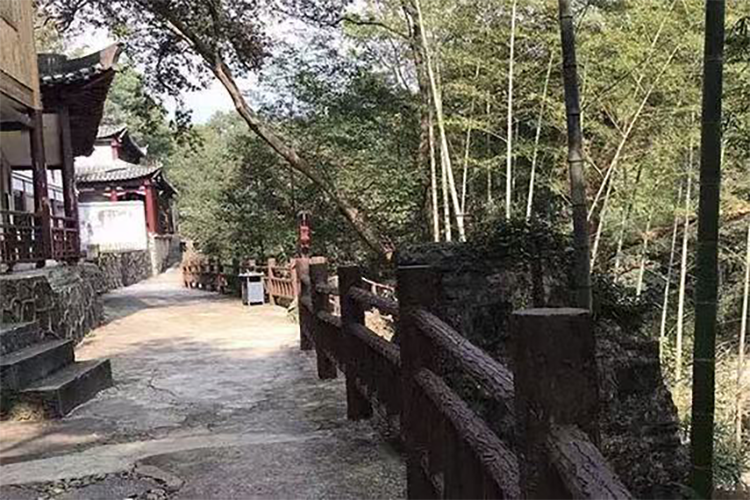Guanyin Bridge: Northern Song Stone Arch Bridge — A Must-See Historic Site
Introduction
Hidden in a deep ravine of Lushan’s Jiujiang region, Guanyin Bridge (观音桥) rests across the Sanxia Ravine like a rainbow frozen in time. Built from 107 precisely fitted granite blocks, this single-arch stone bridge dates to the Northern Song dynasty. With no cement, a span of 24 meters and a width of 4 meters, it stands as both an engineering marvel and a living cultural monument where Su Shi once composed and Huang Tingjian carved inscriptions. The nearby Ming stele and the incense-scented Guanyin Pavilion still whisper stories across centuries.
1. The soul of a millennium: technical precision meets artistry
“One bridge spans a thousand years: the mechanical symphony of 107 granite blocks.” This line captures Guanyin Bridge’s essence. As a nationally protected cultural site, the original Song-era structure demonstrates ancient builders’ mastery of dry-fit stone construction. Each block — some weighing about one ton — locks into place with interlocking joints and mortise-and-tenon techniques, allowing the bridge to endure floods and earthquakes for nearly a thousand years.
Unique selling points:
– World-class bridge craft: predating many European stone arches by centuries, Guanyin Bridge is often called the finest ancient bridge south of the Yangtze.
– A picture-perfect landscape: the bridge, waterfalls, ancient trees and cliff carvings form a natural ink-painting scene that photographs beautifully in every season.
2. Historical depth: from Su Shi’s verse to Ming inscriptions
Northern Song engineering
Guanyin Bridge is not a modern reconstruction but an authentic Northern Song relic. Archaeological study shows its foundation used “sleeping timber” laid on the riverbed — ancient camphor logs that buffer the base and provide seismic resilience, a brilliant example of premodern anti-seismic design.
Literary and epigraphic heritage
– Zhaoyin Spring , north of the bridge, bears an inscription attributed to Huang Tingjian; the water is clear and sweet, once praised as one of the kingdom’s finest springs.
– Su Shi (Su Dongpo) left poetic lines here; his impressions of the nearby peaks are believed to have been inspired by the mountain shapes beside the bridge.

3. Scenic experience: seasonal and hourly transformations
– Best seasons: spring and autumn (April–May, September–October) — higher streamflow and contrasting foliage make the site especially photogenic.
– Weather highlights:
– After rain: waterfalls along the Sanxia Ravine become silver curtains, and mist wraps the bridge in an otherworldly haze.
– Dawn and dusk: slanting light picks out the Ming-era stone inscription on the cliff face, briefly revealing a golden sheen.
4. Deep-dive activities: more than just photos
– Cultural hike: a two-hour, gentle trail along the Sanxia Ravine leads to several Song-period cliff inscriptions and scenic viewpoints.
– Zen experiences: the Guanyin Pavilion on the bridge’s south side offers morning chanting (6:00–7:00) and tea brewed from Zhaoyin Spring.
– Photography tips: the viewing platform 30 meters east offers the best angle for capturing the arch reflecting moonlight — ideal around the full moon.

5. Transportation and visit plan
How to get there
– From Jiujiang city center: about a 40-minute drive by car (search “Guanyin Bridge Scenic Area”) or roughly one hour by Lushan tourist shuttle bus to “Guanyin Bridge Station.”
– Road note: the access road includes about 3 kilometers of switchbacks; drive cautiously.
Suggested routes
– Highlights route (2 hours): entrance → Zhaoyin Spring → Guanyin Bridge → Guanyin Pavilion → Ming stele.
– Family-friendly: flat paved paths with no steps; stroller access is generally possible. A tea pavilion near the bridgehead provides rest.
6. Practical tips: avoid crowds and prepare well
– Tickets: RMB 60 (includes Guanyin Pavilion). Students receive half-price. No reservation usually required, but arrive before 9:00 during peak holidays (National Day, Labor Day).
– Crowd levels: few visitors on weekdays; weekends busier but still tranquil compared with main Lushan attractions.
– Multilingual help: signage includes Chinese and English. English audio guides are rentable (deposit RMB 100).

7. Nearby extras: hidden experiences by the bridge
– Eat: the “Sanxia Farmhouse” near the exit serves local Lushan specialties such as shi ji (stone-roasted chicken), stone fish and mountain mushrooms.
– Stay: consider a cultural homestay in Guizong Temple village on Lushan’s western slope (about 15 minutes by car) for a peaceful, temple-guesthouse experience.
Conclusion
Guanyin Bridge is a silent sage of stone, concentrating centuries of engineering wisdom, literati charm and mountain spirit within a 24-meter arch. It may lack the scale of the Forbidden City or Huangshan’s seas of clouds, but when you trace the weathered granite with your fingers and read the faded poems on the stone, you feel a personal connection to the past. For travelers seeking a quieter, history-rich stop in Jiangxi, Guanyin Bridge offers a rare chance to walk across living history.


